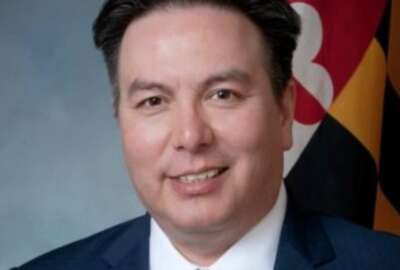 Exclusive
Exclusive  Exclusive
Exclusive Hubbard Radio Washington DC, LLC. All rights reserved. This website is not intended for users located within the European Economic Area.
A new effort under the Unified Shared Services Office and led by the Office of Personnel Management seeks to simplify how agencies and vendors alike view HR fun...
Subscribe to Federal Drive’s daily audio interviews on iTunes or PodcastOne.
For much of the past 30 years, federal human resources systems were like a Frankenstein monster — disparate pieces and parts pulled together to create a working model.
Too often, chief information officers had to connect the electrodes to the often-siloed systems, only to yell, “It’s alive” when the middleware worked to bring the systems together to share data.
A new effort under the Unified Shared Services Office and led by the Office of Personnel Management wants to bring an end to these Franksteined HR systems.
OPM released a new human capital business reference model (HCBRM) in mid-November to simplify how agencies and vendors alike view the operational functions, policy ownership and common structures as part of a plan to better align HR operations, finance and acquisition.
“The HCBRM delivers value because it provides the framework to help streamline, standardize and simplify HR operations for practitioners and employees alike,” OPM acting Director Kathy McGettigan said in a statement. “The potential benefit of this transparency can have a long-lasting impact across the government.”
David Vargas, director of the HR Line of Business for OPM, said the siloed approach created fragmented architectures that posed challenges for the employees and systems alike. Employees who retired saw these challenges firsthand when they tried to gather their historical data, especially if they worked at several different agencies.
He said the updated reference model is the successor to the Bush administration’s e-government initiative and expands the focus of the entire effort.
“The future of HR shared services is foundationally based on organizing the government around a single HR service catalog to facilitate a governmentwide common user experience,” Vargas said in an email to Federal News Radio. “This strategy will allow the adoption of cloud-based software-as-a-service (SaaS) solutions while allowing operational process-based flexibility from agency-to-agency.”
Vargas said this latest effort will ultimately break the functional silos.
The HCBRM will “treat HR service delivery as an end-to-end talent management service offering. Future approved service providers will be considered if they offer end-to-end talent management that complies with the HRLOB talent management services, consistent with the Human Capital Federal Integrated Business Framework standards,” he said.
Vargas added the new framework will eliminate the “core HR” and “non-core HR” categories.
“The HRLOB and the Multi-Agency Executive Steering Committee (MAESC), in collaboration with the CHCO Council and the Unified Shared Services Management office, are now developing baseline governmentwide human capital service standards for all human capital functions in the HCBRM for adoption by agencies,” Vargas said.
He said the standards include:
To that end, OPM, USSM and others will develop a new employee digital record (EDR) to replace the electronic official personnel folder (eOPF) and the enterprise HR integration (EHRI) system.
“The EDR is composed of two parts: EDR data standards and EDR data exchange. EDR data standards are being developed to construct the fully machine-readable employee record that can be used to streamline data exchange across the government,” Vargas said. “The EDR data exchange will function independently from the transaction/application layer of the architecture. Meaning, data management is not dependent on a specific platform, product, or application. The focus of this architecture will be technologies such as cloud-based identity management system, Blockchain and data lake. In the future, the EDR exchange will allow the autonomous and secure exchange of employee record data between federal agencies and service providers, ultimately resulting in a true single employee record throughout the employee’s federal career.”
The human resources initiative is following the same technology path that the financial management effort has been moving down, where it’s getting away from the piecemeal approach and lets agencies buy the service. The Office of Management and Budget and the USSM announced in January a new concept of operations and released a request for information about how this “as-a-service” approach would work.
Jeff Koch, a former OMB official during the Bush administration, said the continued drive to having common business processes is necessary for a true shared service environment.
“Having business processes agreed-upon by every agency enables apples-to-apples comparison of performance between agencies and mobility between shared service providers,” he said. “[OPM director nominee] Jeff Pon was one of the original leaders of the HRLOB who saw the potential of unburdening the CHCOs from having to run their own HR IT systems. And, because all of the HR shared service providers, both government and private, have agreed to comply with the BRM, this is effectively the mechanism by which OPM promulgates policy — implementing changes in every HRIT system simultaneously.”
Other experts, however, aren’t as enthusiastic about OPM’s latest effort.
Linda Rix, co-CEO of Avue Technologies, and a vocal critic of many current federal HR initiatives, said she’s concerned that the business reference model is focused on the past and not the future.
“They are silent on labor economics. They are silent on labor market potential sources of stress, like cyber. They are silent on workforce elasticity, the ability to grow and shrink on demand and provide agility to managers. They still are in a ‘job for life’ traditional view of HR,” Rix said in an interview with Federal News Radio. “That isn’t going to help the federal government get to where it needs to be to position HR programs, services and systems in the future. There still are too many variables.”
Rix pointed to the reference model’s 15 functions and 54 subfunctions as evidence of the backward view.
“If you are proposing a structure that is applied governmentwide as a one-size fits all, then you should know whether or not you have statutory support to do those things,” she said. “To have 54 subfunctions released in an official document that has no tie to the statute is irrational. It should be tied to the statue or be optional for the agency based on mission or business needs. I found that to be a stunning omission.”
She said the HRLOB should stick to the basics of the Classification Act of 1949, the Equal Pay Act of 1963 and other legislative requirements. Rix said everything else should be discretionary based on agency needs and missions.
“The standard HRLOB should be the minimum, and everything else should be discretionary to let senior management get what they need. They know the frustration with dealing with this one-size-fits-all HR framework,” she said.
But Vargas said a major part of this effort is to streamline standards and service delivery, and uncomplicate the process.
“The OPM/HRLOB is actively engaging agency CHCOs and Multi-Agency Executive Steering Committee (MAESC) representatives to tailor agency-specific strategies to leverage the HCBRM taxonomy and categorical structure for HR operational assessments, Workforce planning, process optimization, HRIT Portfolio planning modernization, and budget formulation,” he said. “In addition, the HRLOB is working with OMB and GSA to align acquisition and financial reporting codes to the HCBRM taxonomy. The HRLOB is also working with the OMB Federal Architecture and Technology Business Management (TBM) teams to use the HCBRM as a model for the next version of the Federal Enterprise Architecture (version 3.0). Furthermore, the HRLOB is leading the effort to develop a governmentwide HR service catalog.”
Additionally, Vargas said he expects GSA to release a draft RFQ in the first quarter of fiscal 2018 for the next iteration of the e-payroll initiative. He said the draft RFQ will help improve the final one that is expected to be out in the second quarter of 2018. GSA released an RFI in July 2016 and used those responses to develop the draft solicitation.
Copyright © 2024 Federal News Network. All rights reserved. This website is not intended for users located within the European Economic Area.
Jason Miller is executive editor of Federal News Network and directs news coverage on the people, policy and programs of the federal government.
Follow @jmillerWFED
 Exclusive
Exclusive 
